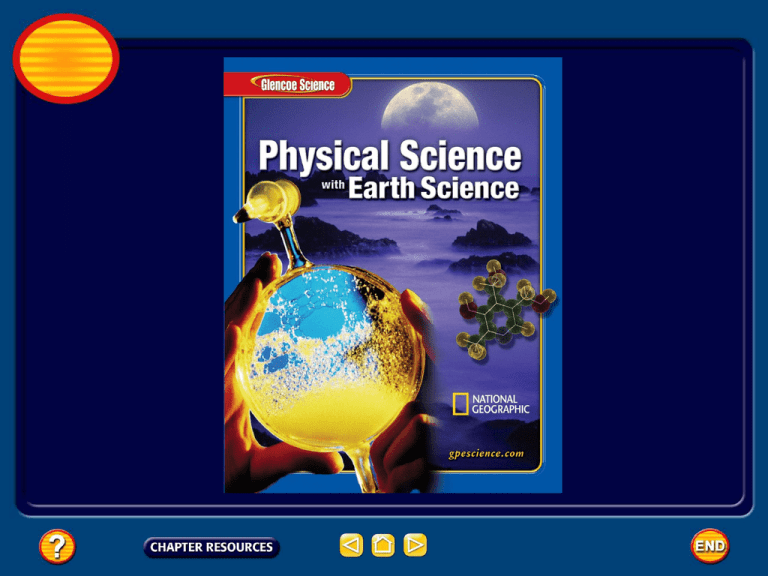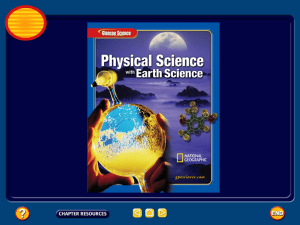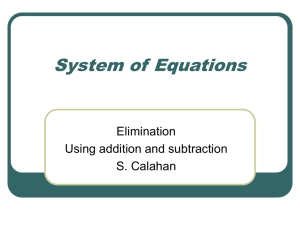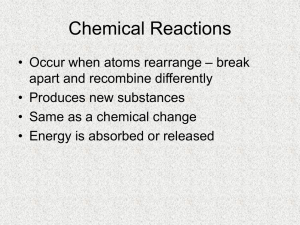Chapters 23: Chemical Reactions
advertisement

Table of Contents Chapter: Chemical Reactions Section 1: Chemical Changes Section 2: Chemical Equations Section 3: Classifying Chemical Reactions Section 4: Chemical Reactions and Energy Chemical Changes Chapter 23 1 Describing Chemical Reactions • A chemical reaction is a change in which one or more substances are converted into new substances. A chemical reaction occurs when you bake a cake. Chemical Changes 1 Writing Equations • A chemical equation is a way to describe a chemical reaction using chemical formulas and other symbols. Chemical Changes 1 Describing Chemical Reactions • The materials that you begin a chemical reaction with are known as reactants. • The new substances created in a chemical reaction are called products. • This relationship can be written as follows: Chemical Equations Using Equations to Represent Reactions During a chemical reaction, the reactants change into products. You can summarize this process with a word equation. Reactants Products • Chemical reactions can be written in different ways. – A word equation: • Nitrogen monoxide + oxygen nitrogen dioxide – A symbolic equation: NO(g) + O2(g) NO2(g) STATE OF MATTER - Letters indicate the state of each compound. (aq) = aqueous/dissolved in water (s) = solid ( l ) = liquid (g) = gas (c) Word Equations • A WORD EQUATION describes chemical change using the names of the reactants and products. Write the word equation for the reaction of methane gas with oxygen gas to form carbon dioxide and water. methane + oxygen Reactant CH4 + 2 O2 carbon dioxide +water Product CO2 + 2 H2O Symbols used in Chemical Equations Symbol Purpose + Separates more than one reactant or product Separates reactants from products. Indicates direction of reaction (s) Identifies a solid state (aq) Identifies that something is dissolved in water (l) Identifies liquid state (g) Identifies gaseous state Chemical Reactions and Energy 4 Chemical Reactions—Energy Exchanges • Chemical bonds contain potential energy. • When bonds are broken energy is released • This energy can take many forms, such as heat, light, sound, or electricity. Chemical Reactions and Energy 4 More Energy In • Sometimes a chemical reaction requires more energy to break bonds than is released when new ones are formed. • These reactions are called endergonic reactions or endothermic • The energy absorbed can be in the form of light, heat or electricity. Chemical Reactions and Energy 4 Exergonic Reactions: • Chemical reactions that release energy are called exergonic reactions • Less energy is required to break bonds than is released when new bonds form. • Chemical reactions tell you what type of molecules are involved in the reaction and how many of each molecule is present • 2NO(g) + O2(g) 2NO2(g) COEFFICIENTS: - Indicates how many of each molecule there is. -Ie: there are 2 molecules of NO. (c) • During a chemical reaction new compounds are created • The Law of Conservation of Mass: Mass of reactants = mass of products • Matter is not created or destroyed instead, atoms are rearranged (c) Chemical Equations Because of the Law of Conservation of Mass, an equation must be balanced. It must have the same number of atoms of the same kind on both sides. Lavoisier, 1788 Chemical Equations 2 Balanced Equations • A reaction between mercury(II) oxide reaction can be written as: • Notice that the number of mercury atoms is the same on both sides of the equation but that the number of oxygen atoms is not the same. Chemical Equations 2 Balanced Equations • According to the law of conservation of mass: • The amount of matter must remain constant during a chemical reaction. • We must balance chemical equations to illustrate that mass is not created or destroyed during a chemical reaction. Chemical Equations 2 Balanced Equations • The formulas in a chemical equation must accurately represent the compounds that react. • Fixing this equation requires a process called balancing. • The balancing process involves changing coefficients in a reaction to achieve a balanced chemical equation, which has the same number of atoms of each element on both sides of the equation. Chemical Equations 2 Choosing Coefficients • Finding out which coefficients to use to balance an equation is often a trial-and-error process. Chemical Equations 2 Choosing Coefficients • If you put a coefficient of 2 before the HgO on the left, the oxygen atoms will be balanced, but the mercury atoms become unbalanced. • To balance the equation, also put a 2 in front of mercury on the right. The equation is now balanced. Chemical Equations 2 Try Your Balancing Act • Magnesium burns with such a brilliant white light that it is often used in emergency flares. • Burning leaves a white powder called magnesium oxide. • To write a balanced chemical equation for this and most other reactions, follow these four steps. Chemical Equations 2 Try Your Balancing Act • Step 1 Write a chemical equation for the reaction using formulas and symbols. • Step 2 Count the atoms in reactants and products. Chemical Equations 2 Try Your Balancing Act • Step 3 Choose coefficients that balance the equation. • Remember, never change subscripts of a correct formula to balance an equation. Chemical Equations 2 Try Your Balancing Act • Step 4 Recheck the numbers of each atom on each side of the equation and adjust coefficients again if necessary. Section Check 2 Answer The answer is D. Oxygen is a diatomic molecule. To balance an equation, change the coefficients, not the subscripts. Classifying Chemical Reactions 3 Types of Reactions • There are literally millions of chemical reactions that occur every day. • Chemists have defined five main categories of chemical reactions: combustion, synthesis, decomposition, single displacement, and double displacement. Classifying Chemical Reactions 3 Combustion Reactions • If you have ever observed something burning, you have observed a combustion reaction. • Our definition states that a combustion reaction occurs when a substance reacts with oxygen to produce energy in the form of heat and light. Classifying Chemical Reactions 3 Combustion Reactions • Combustion reactions also produce one or more products that contain the elements in the reactants. Classifying Chemical Reactions 3 Synthesis Reactions • In a synthesis reaction, two or more substances combine to form another substance. • The generalized formula for this reaction type is as follows: A + B AB. Classifying Chemical Reactions 3 Decomposition Reactions • A decomposition reaction is just the reverse of a synthesis. • Instead of two substances coming together to form a third, a decomposition reaction occurs when one substance breaks down, or decomposes, into two or more substances. Classifying Chemical Reactions 3 Decomposition Reactions • The general formula for this type of reaction can be expressed as follows: AB A + B. • Most decomposition reactions require the use of heat, light, or electricity. Classifying Chemical Reactions 3 Single Displacement • When one element replaces another element in a compound, it is called a single-displacement reaction. • Single-displacement reactions are described by the general equation A + BC AC + B. • Here you can see that atom A displaces atom B to produce a new molecule AC, a single displacement reaction. Classifying Chemical Reactions 3 The Activity Series • We can predict which metal will replace another using the diagram shown which lists metals according to how reactive they are. • A metal will replace any less active metal. Classifying Chemical Reactions 3 Double Displacement • In a double-displacement reaction, the positive ion of one compound replaces the positive ion of the other to form two new compounds. • A double displacement reaction takes place if a precipitate, water, or a gas forms when two ionic compounds in solution are combined. Classifying Chemical Reactions 3 Double Displacement • A precipitate is an insoluble compound that comes out of solution during this type of reaction. • The generalized formula for this type of reaction is as follows: AB + CD AD + CB. Classifying Chemical Reactions 3 Oxidation-Reduction Reactions • One characteristic that is common to many chemical reactions is the tendency of the substances to lose or gain electrons. • Chemists use the term oxidation to describe the loss of electrons and the term reduction to describe the gain of electrons. Classifying Chemical Reactions 3 Oxidation-Reduction Reactions • Chemical reactions involving electron transfer of this sort often involve oxygen, which is very reactive, pulling electrons from metallic elements. • Corrosion of metal is a visible result. Classifying Chemical Reactions 3 Oxidation-Reduction Reactions • The substance that gains an electron or electrons obviously becomes more negative, so we say it is reduced. • On the other hand, the substance that loses an electron or electrons then becomes more positive, and we say it is oxidized. Classifying Chemical Reactions 3 Oxidation-Reduction Reactions • The electrons that were pulled from one atom were gained by another atom in a chemical reaction called reduction. • Reduction is the partner to oxidation; the two always work as a pair, which is commonly referred to as redox. Section Check 3 Question 1 In a _________ reaction, two or more substances combine to form another substance. A. B. C. D. combustion displacement decomposition synthesis Section Check 3 Answer The answer is D. The generalized formula for synthesis reactions is A + B AB. Section Check 3 Question 2 The opposite of a synthesis reaction is a __________ reaction. A. B. C. D. combustion double displacement decomposition single displacement Section Check 3 Answer The answer is C. A decomposition reaction occurs when one substance breaks down into two or more substances. Section Check 3 Question 3 The reaction in which the positive ion of one compound replaces the positive ion of the other to form two new compounds is the __________ reaction. A. B. C. D. combustion double displacement decomposition single displacement Section Check 3 Answer The answer is B. A double displacement takes place if a precipitate, water, or a gas form when two ionic compounds in solution are combined. Chemical Reactions and Energy 4 Chemical Reactions—Energy Exchanges • A dynamic explosion is an example of a rapid chemical reaction. • Most chemical reactions proceed more slowly, but all chemical reactions release or absorb energy. Chemical Reactions and Energy 4 Chemical Reactions—Energy Exchanges • When most chemical reactions take place, some chemical bonds in the reactants are broken, which requires energy. • In order for products to be produced, new bonds must form. Bond formation releases energy. Chemical Reactions and Energy 4 More Energy Out • As a result, some form of energy, such as light or heat is given off by the reaction. • The familiar glow from the reaction inside a glow stick is an example of an exergonic reaction, which produces visible light. Chemical Reactions and Energy 4 Heat Release • When the energy given off in a reaction is primarily in the form of heat, the reaction is called an exothermic reaction. • The burning of wood and the explosion of dynamite are exothermic reactions. Chemical Reactions and Energy 4 Heat Absorption • When the energy needed is in the form of heat, the reaction is called an endothermic reaction. • Some reactions are so endothermic that they can cause water to freeze. • One such endothermic reaction is that of barium hydroxide (BaOH)2 and ammonium chloride (NH4Cl) in water. Chemical Reactions and Energy 4 Heat Absorption • Energy from the surrounding environment is absorbed, causing a cooling effect. • Here, the reaction absorbs so much heat that a drop of water freezes and the beaker holding the reaction sticks to the wood. Chemical Reactions and Energy 4 Catalysts and Inhibitors • Some reactions proceed too slowly to be useful. • To speed them up, a catalyst can be added. • A catalyst is a substance that speeds up a chemical reaction without being permanently changed itself. Chemical Reactions and Energy 4 Catalysts and Inhibitors • When you add a catalyst to a reaction, the mass of the product that is formed remains the same, but it will form more rapidly. Chemical Reactions and Energy 4 Catalysts and Inhibitors • At times, it is worthwhile to prevent certain reactions from occurring. • Substances called inhibitors are used to slow down a chemical reaction. • One thing to remember when thinking about catalysts and inhibitors is that they do not change the amount of product produced. They only change the rate of production. Section Check 4 Question 1 What is the difference between exergonic and exothermic? Answer An exergonic reaction is a chemical reaction that releases energy. An exothermic reaction is an exergonic reaction that releases heat. Section Check 4 Question 2 When heat is needed for a chemical reaction, it is called an __________ reaction. A. B. C. D. endergonic endothermic exergonic exothermic Section Check 4 Answer The answer is B. In an endothermic reaction, energy is needed in the form of heat. Section Check 4 Question 3 What is the substance that speeds up a chemical reaction without being permanently changed itself? Answer A substance that speeds up a chemical reaction without being permanently changed itself is called a catalyst. Help To advance to the next item or next page click on any of the following keys: mouse, space bar, enter, down or forward arrow. Click on this icon to return to the table of contents. Click on this icon to return to the previous slide. Click on this icon to move to the next slide. Click on this icon to open the resources file. Click on this icon to go to the end of the presentation. End of Chapter Summary File








